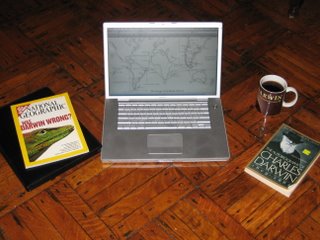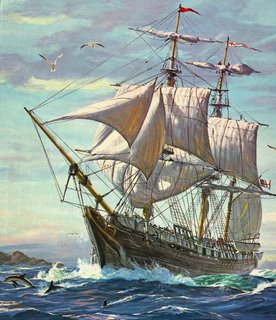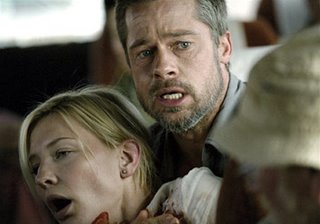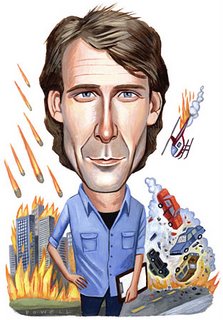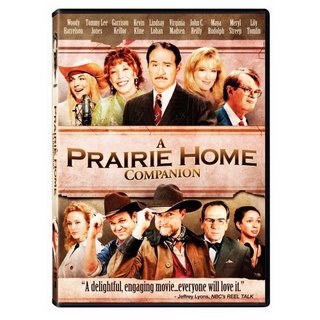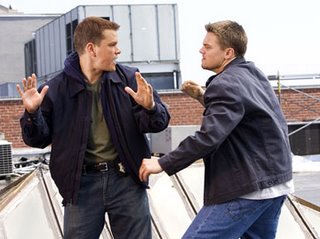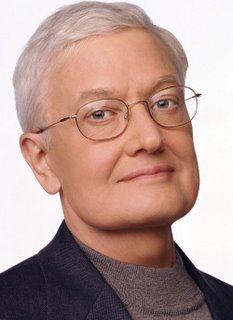 For those of you who begged me to come back with lots of notes and pictures, this blog is for you! Feel free to click on most of the pictures for larger images. I may even have a video or two shortly!
For those of you who begged me to come back with lots of notes and pictures, this blog is for you! Feel free to click on most of the pictures for larger images. I may even have a video or two shortly!I've never been so close to the stuff of my dreams.
When
Neil woke me up Friday morning with a text message asking me if I wanted to accompany him to Christie's Auction House for the
single largest Star Trek merchandise auction in history, I typed back: "Does Spock have pointy ears!?"
Not bad when your first-ever auction takes place at the famed Christies at Rockefeller Center. And when it involves your life's single largest obsession.
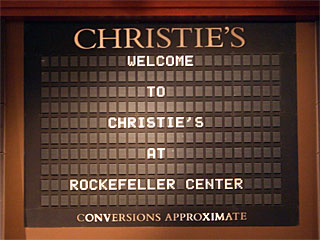
Over the course of three full days (I attended the final two), more than 1,000 lots comprising more than 4,000 items were sold. From the smallest to the largest props, furniture and set pieces, weaponry, jewelry and prosthetic items, uniforms and costumes, starship models (including the original shooting models for all the series', minus the original TV show--that one hangs in the Smithsonian), and a full-size bridge replica. And, of course, tribbles.


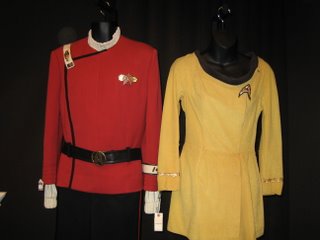

The media was everywhere, still-cameras clicking away, digital video cameras rolling. The History Channel streamed all three days live online.
Tickets to the auction floor were a precious commodity, chosen by a lottery system. (Thank you Neil and Kyrie!) I was there as a gawker, not a buyer. Almost nothing, not even the smallest item, went for less than a grand. While some items were theoretically within my reach--not that they wouldn't have taken years to pay off when coupled with my massive grad school bills--an actual uniform worn by William Shatner or Patrick Stewart would be worth four or five grand, no? Neil commented that it was a shame that this sort of once-in-a-lifetime opportunity came at such a cash-strapped stage in my life. Indeed. It was enough, I had to keep telling myself, just to be there, to actually see some of these items up close, to be a part of such a momentous event, to live vicariously through those with far larger resources than I.

Up at the front of the room, throughout the weekend, sat the Enterprise A and D. With no signs to tell me not to touch, I lovely stroked the hulls of both vessels, gliding my finger's gently along their resin skins, imagining myself as particles of stellar dust. These were not simply models of my favorite celestial chariots--they were those very chariots.
* * *
PICARD (puts his hand on the Phoenix): " It's a boyhood fantasy... I must have seen this ship hundreds of times in the Smithsonian but I was never able to touch it."
DATA: "Sir, does tactile contact alter your perception of The Phoenix?"
PICARD: "Oh, yes! For humans, touch can connect you to an object in a very personal way, make it seem more real."
DATA (also puts his hand on the ship): "I am detecting imperfections in the titanium casing... temperature variations in the fuel manifold... it is no more 'real' to me now than it was a moment ago."
TROI (observing from a catwalk): Would you three like to be alone?"
--
Star Trek: First Contact* * *
No one in that room looked at me oddly or thought me weird. I was with people who loved what I loved in the same way I loved it. We may have been a room full of misfits, but we were all misfits and we reveled in it. (For those of you who assume the auction floor must have resembled a Star Trek convention, only one bidder showed up in a full costume, but as he was British, middle-aged, bald and even resembled Patrick Stewart, he pulled it off.)
I suppose I expected the mainly British auctioneers to be stogy and staid, the paradigms of upper-class reserve. What I didn't expect was how funny they actually were, cracking dry jokes and making playful comments. This was especially true when the auctioneer was obviously not familiar with the items he or she was selling. The following are actual auctioneer comments I heard:
"Riker's...excuse me...
boy toy outfit?!"
"Next lot is...Wolf's spinal column...riiiiight."
"Having just sold the Borg head, our next lot is...a Borg arm. Keep this up and we'll have a whole Borg body by the end of the night."
"Sold for $45,000. Would like to come back next week for the Monet's sir?"
"Arggg! The pirate costume!"
"Klingon wallpaper...I mean wall panel. Oh you know what I mean...I hope some of you are redecorating. This would look great in the bedroom."
"Lot 657, the Romulan Prison Camp model. Oh, booooooo, hissssssss."
"Don't look at your wife. Look at me. You don't need her permission. It's only money."
"$4000 for two tribbles. That's only 2000 a fuzz-ball! What a deal."
"Next is Dr. McCoy's medical smock. Anyone want to play doctor?"
"35,000...38,000...42,000...what in the world are we selling here!?"
"Stop that, you don't have to roll your eyes every time you bid."
"What do you mean 'No?' You've just spent $22,000...what's another $2,000!?"
"Kirstie Alley's uniform. I assume this is post Jennie Craig then...I know, I know...I'm sorry..."
"Six thousand dollars for that!? I wouldn't feel too badly that you didn't get it madam. I can make you one with my desk scraps after we're done here."
"$750 to the internet...someone out there badly needs pants. It's a good thing they're at home and not here with us. History Channel isn't that sort of cable channel."
"Lot 961...which is, if I'm not mistaken, the year we started this auction. I'm sorry, but you all look exhausted. Do I look as bad as you guys?"
More often than not, the auctioneers had no idea how to pronounce the various alien or character names, and usually just skipped them altogether. "Vulcan High Priest Kohlinahr Master's Robe" became simply, "Vulcan...robe."
"Next lot is a...er...I have no idea in hell what that is. Some alien thingymagiggy..."
Sometimes they made valiant efforts:
"Card...um,...Cardas...um, C-something-or-other self-sealing stem bolt."
"Next we have Lt. Zulu's uniform... What? Oh my, so sorry. Sulu's uniform."
Unencumbered by a bidding paddle, I enjoyed consulting my catalogue books (the real keepsakes of the weekend), trying to predict what would go for huge amounts.

It was hilarious to see the auctioneers blanch at prices they deemed absurd for what was being purchased. Pikard's Ressikan flute (from the beloved episode "The Inner Light"), estimated at $800-1,200 went for an astonishing $40,000! Even a handful of stickers that were used to simulate buttons on
The Next Generation's consoles went for over a thousand dollars.

Aside from hundreds of buyers on the floor (several of whom bid on items they had no hope of procuring but wanted to be able to say they'd tried), a wall of pretty girls lined one of the walls, phones glued to their ears. Another several hovered over computer screens calling out internet bidders.

When someone in the room beat the anonymous--and apparently bottomless bankrolled--phone bidders, especially if it was for an obscenely large amount of money, the room erupted in applause. The winning bidder was oftentimes smothered by his or her (yes, there were many "hers") seatmates. Some of the larger items incited standing ovations no matter who won them.

I sat in the very back of the room and had my Mac open most of the second day (Neil had to leave after only a few hours the first day to go run his planetarium). While I was recording impressions, downloading pictures and even dabbling with a bit of homework, it occurred to me finally why so many people who passed by eyed me with curiosity and suspicion. They thought I was one of the online bidders anonymously gobbling up merchandise from those present on the floor. Emboldened, I did nothing to disabuse them of these impressions.
As big items drew closer, you could feel the air begin to crackle. People shifted forward in their seats, licking their lips in anticipation. Christies admitted the interest and energy for the show caught them completely off guard. Their catalogue estimates and the actual amount of money that came in for the items were light years apart. For instance, an item listed for $300-500 regularly went for 4 or 5 times that amount, if not more. This was the sort of event in which tens of thousands of dollars was spent in seconds.
The Enterprise-E (
First Contact and
Nemesis) went for $120,000 (which doesn't even take into account the 20% commission and other fees on top of that that all items are saddled with), when it was estimated to go for only $8,000-12,000. The Borg Cube, thought to draw no more than $1,500 took $80,000! The DS9 space station, with a high estimate of $12,000 went home with a $110,000 bidder!
They saved the best stuff for the last day. Saturday's items included original cast movies costumes, captain chairs, bridge set pieces, and, of course, the Enterprise-D (
The Next Generation) and the ultimate item, the Enterprise-A (
Original Trek movies).
The bridge set went for $30,000. When someone in the crowd called out, "That's so cheap," I had to nod my head in ready agreement.

The Enterprise-D was sold for a perfect half a million, one of the highest prices ever paid for any piece of Hollywood memorabilia.
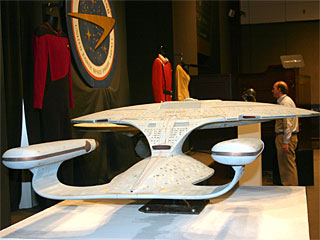


When the final bid of the auction, #1000, the Enterprise A came up, the Star Trek theme song began playing loudly over the speakers. We all rose unanimously to our feet and I'd be lying if I said I didn't have tears in my eyes. However, what began as a deeply emotional moment quickly turned into a shocking and even enraging one. Normally I would never call a quarter of a million dollars "cheap," "a steal" or "an injustice" but these are all things I said aloud when the USS Enterprise A model sold for only $240,000. We all stood dumbfounded, disbelieving what we'd just seen. The only explanation we could think of? Everyone had already spent what they had on the other 999 lots and had little left to spend on the most valuable item of the entire auction. For fraks sake, the Bird of Prey sold for more ($260,000)! Whoever will be bringing the great lady home got her for chump change and while I'm happy for them, it chaffed me the rest of the evening. It chaffs me still.
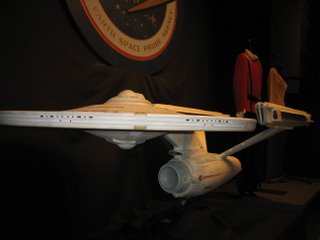


At the end of evening, after the final slide read "End of Sale," and the auctioneer invoked William Shatner's infamous Saturday Night Live line by saying, "It's over. Now go get a life," the auction drew in a stellar 7.1 million dollars--almost four times the amount Christies estimated they'd receive.
At one point I recognized Michael and Denise Okuda in the audience. Michael is Star Trek's graphic art supervisor and the technical advisor responsible for the overall look of the franchises' control panels, signage, alien written languages and computer readout animation. His wife, Denise, is a Star Trek researcher, artist and author. They'd spent the last 8 months planning this weekend. I asked them if it felt as if they were selling their children.
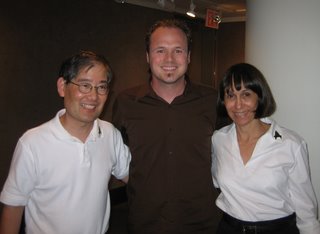
"Oh no," Denise pipped up, "Are you kidding!? These things were wasting away in crates somewhere in L.A. Now they are going to go home with fans who will lavish them with the sort of love and care they deserve. They're going to a far better place."
Though I can't take any of these things home with me, they will, of course, remain with me in my heart, where they've been all along. What an out-of-this-world weekend.
If you're interested in what some of the other items sold for, here are just a few examples:
Dixon Hill outfit: 2,800
Captain Picard's 1st season uniform: 20,000
Enterprise C: 40,000
Ferengi Shuttle: 7,300
Romulan warbird: 30,000
Cardasian Cruiser: 20,000
Ferengi Marauder: 15,000
Vulcan starship: 12,000
A replica of Kirk's original captain's chair: 9,000
Kirk's Wrath of Khan uniform: 8,500
Ilia's off-duty tunic and Deltan headband: 9,000
Spock's IV headband: 3,800
Spock's re-birth gown: 8,000
Klingon warrior custom: 8,000
Original Series Space Suit: 120,000
Battle Damaged USS Reliant: 24,000
USS Reliant: 50,000
Galileo shuttlecraft: 12,000
Regula One Space Station: 42,000
Space Dock: 65,000
Self-Destructed Enterprise: 40,000
Klingon Battlecruiser: 85,000
USS Excelsior: 110,000




